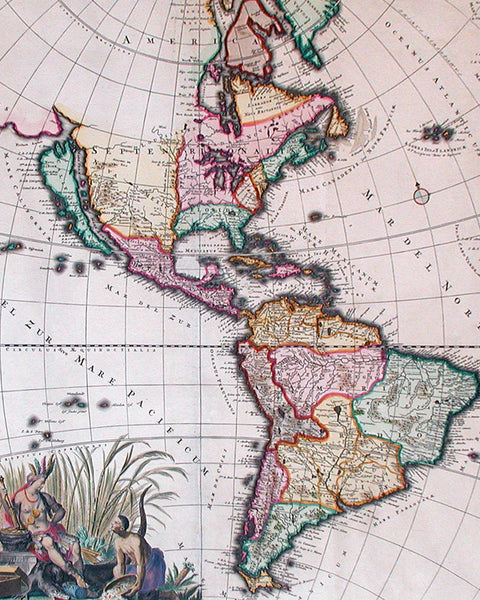Arader Galleries
America Settentrionale (North America)
Pickup currently unavailable
Vincenzo Coronelli (1650 - 1718)
America Settentrionale (North America)
From Atlae Veneto
Copperplate Engraving
Domenico Padonani, Venice ; 1690
Two maps both 27 x 33 inches (framed)
$25,000
As Royal Cartorgrapher to King Louis XIV, mapmaker Vincenzo Coronelli had special access to the most current records on American geography sent in from the colonies. Coronelli compiled this four-part map of the Americas while in Paris between 1681 and 1683 to construct a pair of huge globes for the French king, where his position as 'geographe du roi' and his influential contacts in Paris enabled Coronelli to obtain manuscript maps of New France. He was able, therefore, to incorporate the most recent discoveries into this map, most notably the exploits of La Salle. The configuration of the Great Lakes, based on that which appears on the terrestrial globe for Louis XIV, was a model used by Coronelli with only slight changes on all his subsequent maps over the next two decades.
In 1684 Coronelli returned to Venice and founded the Accademia Cosmografica degli Argonauti, a georgraphical society with membership drawn from the aristocracy and church hierarchy, and a year later he was appointed Cosmographer to the Republic of Venice. With a secure financial base provided by the society, Coronelli could ensure that America Settentrionale would be widely dispersed across Europe. An influential and important map, Coronelli's was not without its flaws, the most famous example, of course, being the representation of California as a mammoth island. Still, the development of European awareness of the shape of the Americas is depicted with vivid clarity on Coronelli's striking map.
Coronelli was both a cleric and encyclopedist, with a particular interest in geography and cartography. He joined the Franciscan Order in Venice in 1665 and six years later entered the convent of Santa Maria Gloriosa dei Frari, which was to become his professional workshop. He was sole author or contributor to over one hundred and forty titles and produced several hundred maps, either printed separately or as parts
of atlases. At the end of the 17th century, he was perhaps the most famous map publisher in Europe and received constant requests from his contemporaries for information that would enable them to bring their atlases up to date. Shortly after his death, however, his name and work were quickly forgotten, and he remained in obscurity for several centuries. The lasting influence of his work is undeniable, however, and modern appreciation has more than compensated for the earlier lack of recognition.


